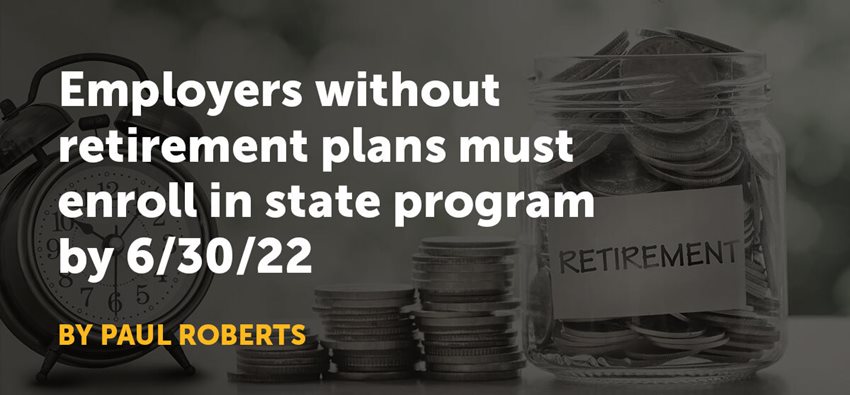California Employers Without Retirement Plans Must Enroll in State Program by 6/30/2022

California enacted a new law in 2016 requiring employers that do not already sponsor an employee-retirement plan to participate in a state-run retirement program called CalSavers. Employers with 5 or more employees (of any type – full time, part time, seasonal) must enroll in the program by June 30, 2022.
Since inception, all California businesses have been eligible to participate in the CalSavers program; however, the approaching final registration deadline of June 30, 2022, encompasses all employers with five or more employees. Employers with more than 100 employees had a prior registration deadline of September 30, 2020. Employers with more than 50 employees had a prior registration deadline of June 30, 2021. An employer that already sponsors, or begins to sponsor, a traditional retirement plan ahead of the deadline does not have a CalSavers participation requirement.
Additionally, Californians can enroll on their own as individuals if they do not have access to a retirement savings plan through an employer.
The CalSavers program is not intended to be a traditional retirement plan. Instead, it is a state-run program to help employees begin thinking about and saving for retirement. It aims to remove many of the complexities involved in sponsoring a traditional retirement plan, which can be especially challenging for smaller employers due to federal ERISA law.
Most importantly, CalSavers does not make employers ERISA plan fiduciaries. An important caveat is that the employer must not advise its employees on where to invest funds, and the employer can neither encourage nor discourage participation in the program. If an employer does either of these things, then ERISA law would require the employer to become the plan fiduciary, which would bring additional compliance challenges to the employer.
While the program is voluntary for employees, the law requires employers to provide employee information to the CalSavers program, which will be used by CalSavers to enroll employees (who do not opt out during automatic-enrollment). Employees must be enrolled in the program by the group size-specific deadline, or within 30 days after date-of-hire for employees hired after the deadline.
When employees are enrolled, they begin a 30-day decision period when they can leave the plan as-is, make changes to the plan (contribution changes, etc.), or opt-out of the program entirely. During this window, employers must work with their payroll providers to begin providing deduction amounts for employees. At the conclusion of the 30-day period, unless changes are made, employees will be enrolled in the program beginning with a 5% payroll deduction.
Employees can customize their enrollments in several ways: change the contribution rate, change investment fund choices, designate beneficiaries, manage personal information, make a withdrawal, or set up additional personal contributions.
Employees can contribute anywhere from 0% to 100% of salary, up to the annual federal IRA contribution limits ($6,000 for those below age 50, and $7,000 for those 50 and above). Employees can make changes to their plans at any time throughout the year, including opting out.
Funds withheld from employees’ paychecks are based on gross income, and are withheld on a post-tax basis. The funds go into a Roth IRA; however, employees have the option of re-characterizing the program into a traditional IRA. Regardless of the employee’s IRA type, the plan will always belong to the employee. Unless an employee selects specific investments, initial contributions will be invested in the CalSavers Money Market Fund for thirty days. After thirty days from the first contribution, all subsequent contributions, along with any earnings in the Money Market Fund, will be re-allocated to a CalSavers Target Retirement Fund, based on the employee’s age and year in which the employee is most-likely to retire (based on employee’s age).
Employers will not incur fees for participating in the program; however, it’s important to understand that employers cannot contribute to employees’ plans. Doing so would make them the plan’s ERISA fiduciary, with complex compliance responsibilities. If an employer wants to make contributions to employees’ retirement plans, it can do so via a traditional retirement plan.
CalSavers offers registration and enrollment services to aid employers in compliance and enrollment; information is available by sending an email to clientservices@calsavers.com. More information, including an in-depth FAQ section, is available on the CalSavers website.
Non-compliance penalties for violation of the retirement-program mandate are hefty, and are assessed by the California Franchise Tax Board. Under Government Code Section 100033(b), each eligible employer that, without good cause, fails to allow its eligible employees to participate in CalSavers on or before 90 days after its deadline, will be fined $250 per W-2 employee.
If noncompliance extends beyond 90 days, employers can be fined up to an additional $500, for a total of $750 per W-2 employee. Employers can be penalized for missing any step of the process – including not registering employees by the deadline, not adding new-hires to the CalSavers system within 30 days, not submitting contribution amounts, cessation of program facilitation, etc.
Although this mandate is not necessarily related to health insurance, it is one of major importance to California employers. Ensuring your clients are aware of the CalSavers deadlines will help you prove your value to your clients – and aid in your client retention and business growth.
Most Recent Articles
Technology
Carrier Updates

